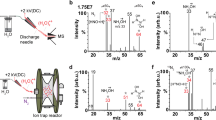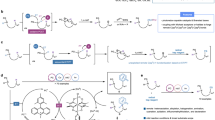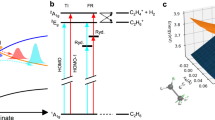Abstract
THE spectrum of the HO2 radical is of considerable importance and several unsuccessful attempts have been made to record it. The HO2 radical has one more electron than the HNO molecule, which has an electronic transition at 7600 Å (ref. 1), and consideration of the molecular orbitals of HO2 suggests that this radical should have a very similar electronic transition to that of HNO (ref. 2). The HNO spectrum was first obtained in absorption during flash photolysis experiments1, but has more recently been observed in emission in the chemiluminescent reaction of hydrogen atoms with NO (ref. 3). The similarity of the bond dissociation energies of H—NO (49 kcal/mole)3 and H—O2 (46 kcal/mole)4 suggests that hydrogen atoms might give a chemiluminescent reaction with oxygen, despite previous failures to find any electronic emission from this reaction.
This is a preview of subscription content, access via your institution
Access options
Subscribe to this journal
Receive 51 print issues and online access
$199.00 per year
only $3.90 per issue
Buy this article
- Purchase on SpringerLink
- Instant access to full article PDF
Prices may be subject to local taxes which are calculated during checkout
Similar content being viewed by others
References
Dalby, F. W., Canad. J. Phys., 36, 1336 (1958).
Walsh, A. D., J. Chem. Soc., 2288 (1953).
Clement, M. J. Y., and Ramsay, D. A., Canad. J. Phys., 39, 205 (1961).
Foner, S. N., and Hudson, R. L., J. Chem. Phys., 36, 2681 (1962).
McKinley, J. D., Garvin, D., and Boudart, M. J., J. Chem. Phys., 23, 784 (1955).
Gaydon, A. G., Proc. Roy. Soc., A, 181, 197 (1942).
Author information
Authors and Affiliations
Rights and permissions
About this article
Cite this article
DIXON, R., MASON, B. Luminescence from the H—O2 Reaction. Nature 197, 1198 (1963). https://doi.org/10.1038/1971198a0
Issue date:
DOI: https://doi.org/10.1038/1971198a0



